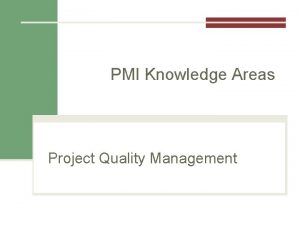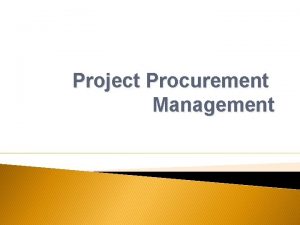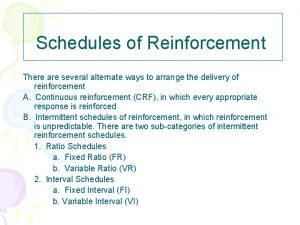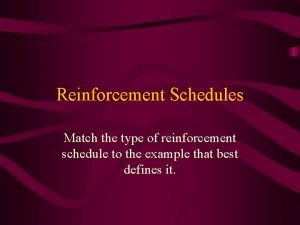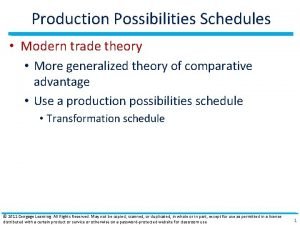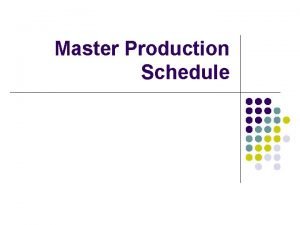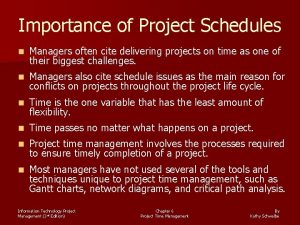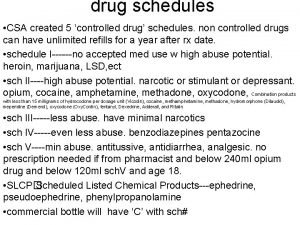Project Time Management Importance of Project Schedules Managers






















- Slides: 22

Project Time Management

Importance of Project Schedules • Managers often cite delivering projects on time as one of their biggest challenges • Average time overrun from 1995 CHAOS report was 222%; improved to 63% in 2001 study • Time has the least amount of flexibility; it passes no matter what • Schedule issues are the main reason for conflicts on projects, especially during the second half of projects

What is Project Time Management? • Project time management includes the processes required to accomplish timely completion of a project. Processes include: – – – Activity definition Activity sequencing Activity resource estimating Activity duration estimating Schedule development Schedule control

Activity Definition • Defining the schedule activities involves identifying and documenting the work that is planned to be performed • Process identifying the deliverables at the lowest level in the WBS, which is called the work package, to provide a basis for estimating, scheduling, executing, and monitoring and controlling the project work • The activity list is a comprehensive list including all schedule activities that are planned to be performed on the project

Activity Sequencing • Involves identifying and documenting the logical relationships among schedule activities (predecessor and successor) • Involves reviewing activities and determining dependencies – Mandatory dependencies: inherent in the nature of the work; hard logic – Discretionary dependencies: defined by the project team; soft logic – External dependencies: involve relationships between project and non-project activities • The project team determines the dependencies that may require a lead (overlap) or a lag (delay) to accurately define the logical relationship

Task Dependency Types

Activity Resource Estimating • Estimating schedule activity resources involves determining what resources (persons, equipment or material) and what quantities of each resource will be used, and when each resource will be available to perform project activities • The resource requirements documentation for each schedule activity can include the basis of estimate for each resource, as well as the assumptions that were made in determining which type of resource are applied, their availability, and what quantity are used

Activity Duration Estimating • Estimating activity duration requires – – • • the amount of work effort required to complete the schedule activity is estimated, the assumed amount of resources to be applied to complete the schedule activity is estimated, and the number of work periods needed to complete the schedule activity is determined (elapsed time) Referring additional time as contingency reserves as recognition of schedule risk Activity duration estimates are quantitative assessments of the likely number of work periods that will be required to complete a schedule activity People doing the work should help create estimates, and an expert should review them

Three-point Estimates • Program Evaluation and Review Technique (PERT) is a network analysis technique used to estimate project duration when there is a high degree of uncertainty about the individual activity duration estimates • PERT uses probabilistic time estimates based on using optimistic, most likely, and pessimistic estimates of activity

PERT Formula and Example • PERT weighted average formula: optimistic time + 4 X most likely time + pessimistic time 6 • Example: PERT weighted average = 8 workdays + 4 X 10 workdays + 24 workdays = 12 days 6 where 8 = optimistic time, 10 = most likely time, and 24 = pessimistic time

Schedule Development • Project schedules grow out of the basic document that initiate a project – Project charter includes start and end dates and budget information – Scope statement and WBS help define what will be done • • An iterative process, determines planned start and finish dates for project activities, that can serve as a baseline against which progress can be tracked Important tools and techniques include Gantt charts, Schedule compression, Critical path analysis, and Resource leveling

Gantt Charts • Gantt charts provide a standard format for displaying project schedule information by listing project activities and their corresponding start and finish dates in a calendar format • Symbols include: – A black diamond: milestones or significant events on a project with zero duration – Thick black bars: summary tasks – Lighter horizontal bars: tasks – Arrows: dependencies between tasks

Gantt Chart for Software Launch Project

Critical Path Method (CPM) • CPM is a project network analysis technique used to predict total project duration • A critical path for a project is the series of activities that determines the earliest time by which the project can be completed • The critical path is the longest path through the network diagram and has the least amount of slack or float

Simple Example of Determining the Critical Path • Consider the following project network diagram. Assume all times are in days. a. How many paths are on this network diagram? b. How long is each path? c. Which is the critical path? d. What is the shortest amount of time needed to complete this project?

Importance of Updating Critical Path Data • It is important to update project schedule information • The critical path may change as you enter actual start and finish dates • If you know the project completion date will slip, negotiate with the project sponsor

Techniques for Shortening a Project Schedule • Shortening durations of critical tasks for adding more resources or changing their scope • Crashing tasks by obtaining the greatest amount of schedule compression for the least incremental cost • Fast tracking tasks by doing them in parallel or overlapping them

Resource Leveling • Resource leveling is a technique for resolving resource conflicts by delaying tasks • The main purpose of resource leveling is to create a smoother distribution of resource usage and reduce overallocation

Sample Histogram Showing an Overallocated Individual

Resource Leveling Example

Schedule Control • Schedule control is concerned with – – • • Determining the current status of the project schedule, Influencing the factors that create schedule changes Determining that the project schedule has changed Managing the actual changes as they occur Using the schedule change control system as the procedures includes the paperwork, tracking systems, and approval levels necessary for authorizing changes Hold progress meetings with stakeholders and be clear and honest in communicating schedule issues

Project Time Management Processes
 Project managers typically perform the tasks of
Project managers typically perform the tasks of Kytc project managers toolbox
Kytc project managers toolbox Introduction to software project management
Introduction to software project management Managers and management chapter 1
Managers and management chapter 1 Managers and management chapter 1
Managers and management chapter 1 Managers and management chapter 1
Managers and management chapter 1 Example of project scope statement
Example of project scope statement Manajemen pengadaan proyek
Manajemen pengadaan proyek Importance of project procurement management
Importance of project procurement management Importance of project cost management
Importance of project cost management Importance of project cycle management
Importance of project cycle management Importance of project quality management
Importance of project quality management Importance of project procurement management
Importance of project procurement management Start time end time and elapsed time
Start time end time and elapsed time The process of acquiring through experience new
The process of acquiring through experience new Operant vs. classical conditioning
Operant vs. classical conditioning Dense schedule of reinforcement
Dense schedule of reinforcement A blueberry picker receives $1 after filling 3 pint boxes.
A blueberry picker receives $1 after filling 3 pint boxes. Learned helplessness
Learned helplessness Creating production possibilities schedules and curves
Creating production possibilities schedules and curves Compound schedules of reinforcement examples
Compound schedules of reinforcement examples Skinner's schedules of reinforcement
Skinner's schedules of reinforcement Master production schedule template
Master production schedule template











